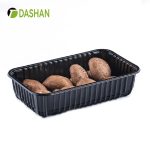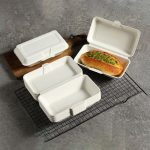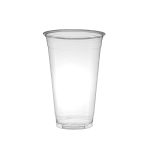Introduction
Disposable food packaging has always been central to how food is sold, consumed, and perceived. From takeaway boxes to supermarket trays, packaging protects food and creates a first impression. But in the past decade, the industry has seen a seismic shift: consumers and regulators demand packaging that balances functionality with environmental responsibility.
This article explores the journey from traditional plastics to eco-friendly alternatives, highlighting how PP (polypropylene), PLA (polylactic acid), and bagasse (sugarcane pulp) are reshaping food packaging. We also look at the role of customization, sustainability certifications, and consumer demand, and explain how DASHAN—a certified packaging manufacturer—delivers innovative, sustainable solutions.
I. From Plastic Convenience to Sustainability Concerns
1. Early Dominance of Plastics
Traditional plastics like PET, PS, and PVC dominated disposable food packaging for decades. They were cheap, strong, and scalable. Supermarkets and restaurants relied on them to package everything from bottled drinks to clamshell burger boxes. However, their low recycling rates and persistence in landfills and oceans triggered growing environmental concerns .
2. Rising Consumer Awareness
By the early 2000s, surveys revealed that more than 60% of consumers factored sustainability into their buying choices . Shoppers began seeking alternatives that aligned with values such as eco-consciousness and health. Packaging became not just a container but a symbol of brand values.
3. The Role of Regulation
Governments worldwide introduced stricter rules:
-
EU Single-Use Plastics Directive (2019) banned items like cutlery and plates.
-
China’s plastic restriction policies mandated a phased ban on non-biodegradable plastics in foodservice.
-
US states (e.g., California, New York) adopted bans and fees on plastic bags and polystyrene.
These pressures accelerated adoption of eco-friendly alternatives like recyclable PP, compostable PLA, and bagasse .
II. Modern Eco-Friendly Materials
1. Polypropylene (PP) — Durable & Recyclable
PP is lightweight, microwave-safe, and recyclable in many regions. It offers clarity, strength, and cost-effectiveness, making it a reliable choice for disposable trays, clamshells, and cups. Unlike polystyrene, PP doesn’t crack easily and maintains food integrity during transport .
2. Polylactic Acid (PLA) — Compostable Bioplastic
PLA is derived from corn starch or sugarcane. It’s compostable under industrial conditions and appeals to eco-conscious brands. PLA cups and lids are especially popular in cafes, though they require specific composting infrastructure .
3. Bagasse — Plant-Based Strength
Bagasse is made from sugarcane fiber left after juice extraction. It’s biodegradable, heat-resistant, and sturdy, making it an excellent replacement for foam trays or plastic plates. Many QSR chains have switched to bagasse-based clamshells for their green initiatives .
4. rPET & CPET — Recycled and Oven-Safe Options
rPET (recycled PET) supports circular economy goals, while CPET is heat-resistant, used in airline meals and ready-to-heat trays .
III. The Impact of Consumer Demand
Case Study: Starbucks & Compostables
Starbucks tested compostable paper cups lined with bioplastics to reduce single-use waste. The trials reflected strong consumer interest, proving that eco-conscious packaging can reinforce a brand’s sustainability story .
Case Study: McDonald’s France
McDonald’s replaced polystyrene clamshells with bagasse fiber containers in France, aligning with EU regulations. The move won praise from NGOs and consumers, showing how packaging choices can elevate brand image .
IV. Packaging Design & Functionality
Packaging is no longer judged only by sustainability—it must also perform flawlessly. Modern consumers expect:
-
Food safety & sealing → Tamper-evident lids to prevent contamination.
-
Convenience → Microwave- and freezer-safe packaging.
-
Branding → Logos, colors, and storytelling printed directly onto packaging.
-
Reusability → Some PP clamshells and trays can be reused before recycling.
Interactive features like QR codes now link packaging to brand stories, sourcing details, or promotions, enriching customer experience .
V. Sustainable Options in 2025 and Beyond
-
Reusable Systems: Deposit-return schemes for cups/containers.
-
Compostable Innovations: Biopolymers that decompose faster in home compost.
-
Material Blends: Fiber + biopolymer hybrids for improved strength and eco-profiles.
-
Circular Economy: Designing for recyclability and keeping materials in loops .
VI. DASHAN — Professional Manufacturer Driving Change

XIAMEN DASHAN NEW MATERIALS CO., LTD is a professional manufacturer with 10+ years of experience in food-grade packaging. Located in Xiamen, China, we supply to 60+ countries, including supermarkets, airlines, and catering services.
Our strengths:
-
Eco-friendly portfolio: PP, PLA, rPET, cornstarch, and bagasse solutions.
-
Full in-house control: Extrusion, thermoforming, and printing.
-
Customization (OEM/ODM): Tailored shapes, branding, and certifications.
-
Certifications: FDA, SGS, LFGB, BRC, ISO 9001, ISO 14001, EN13432, ASTM D6400.
👉 Learn more on our Company Profile.
FAQ
1. Why is PP still popular in eco-friendly packaging?
Because PP is recyclable, durable, and heat-resistant, making it a practical balance between sustainability and performance .
2. Is PLA really compostable everywhere?
PLA requires industrial composting facilities. In regions without such infrastructure, recyclables like PP may be more effective .
3. Why are brands switching to bagasse?
Bagasse is biodegradable, sturdy, and aligned with regulations banning single-use plastics. It signals a clear sustainability message .
4. How does custom packaging improve branding?
Customized logos, colors, and stories printed on packaging improve recognition, loyalty, and perceived value .
5. What makes DASHAN different as a supplier?
Our integrated factory, certified processes, and diverse material portfolio allow us to deliver sustainable, branded solutions fast and reliably.
Conclusion
Disposable food packaging has evolved from being a cheap necessity to a brand-defining, eco-critical tool. Consumers demand greener options, governments enforce stricter rules, and businesses must adapt to stay relevant.
The future belongs to companies that blend functionality, sustainability, and branding—and that’s where DASHAN leads. If you’re ready to switch to certified, eco-friendly, customizable packaging, contact DASHAN today.
References
-
Wikipedia — Food Packaging History https://en.wikipedia.org/wiki/Food_packaging
-
Ipsos — First Impressions Matter in Packaging https://www.ipsos.com
-
European Commission — Single-Use Plastics Directive https://environment.ec.europa.eu
-
Springer — Polypropylene in Food Packaging https://link.springer.com
-
Packaging Europe — PLA and Bioplastics in Packaging https://www.packagingeurope.com
-
Foodservice Packaging Institute — Bagasse Applications https://www.fpi.org
-
Plastics Europe — PET and rPET Packaging https://plasticseurope.org
-
Starbucks Newsroom — NextGen Cup Challenge https://stories.starbucks.com
-
McDonald’s France — Sustainable Packaging Initiative https://corporate.mcdonalds.com
-
Deloitte — Packaging as a Customer Experience Tool https://www.deloitte.com
-
Ellen MacArthur Foundation — Circular Economy for Plastics https://ellenmacarthurfoundation.org




